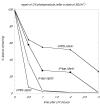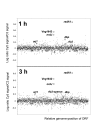UV irradiation induces homologous recombination genes in the model archaeon, Halobacterium sp. NRC-1
- PMID: 16176594
- PMCID: PMC1224876
- DOI: 10.1186/1746-1448-1-3
UV irradiation induces homologous recombination genes in the model archaeon, Halobacterium sp. NRC-1
Abstract
Background: A variety of strategies for survival of UV irradiation are used by cells, ranging from repair of UV-damaged DNA, cell cycle arrest, tolerance of unrepaired UV photoproducts, and shielding from UV light. Some of these responses involve UV-inducible genes, including the SOS response in bacteria and an array of genes in eukaryotes. To address the mechanisms used in the third branch of life, we have studied the model archaeon, Halobacterium sp. strain NRC-1, which tolerates high levels of solar radiation in its natural hypersaline environment.
Results: Cells were irradiated with 30-70 J/m(2) UV-C and an immunoassay showed that the resulting DNA damage was largely repaired within 3 hours in the dark. Under such conditions, transcriptional profiling showed the most strongly up-regulated gene was radA1, the archaeal homolog of rad51/recA, which was induced 7-fold. Additional genes involved in homologous recombination, such as arj1 (recJ-like exonuclease), dbp (eukaryote-like DNA binding protein of the superfamily I DNA and RNA helicases), and rfa3 (replication protein A complex), as well as nrdJ, encoding for cobalamin-dependent ribonucleotide reductase involved in DNA metabolism, was also significantly induced in one or more of our experimental conditions. Neither prokaryotic nor eukaryotic excision repair gene homologs were induced and there was no evidence of an SOS-like response.
Conclusion: These results show that homologous recombination plays an important role in the cellular response of Halobacterium sp. NRC-1 to UV damage. Homologous recombination may permit rescue of stalled replication forks, and/or facilitate recombinational repair. In either case, this provides a mechanism for the observed high-frequency recombination among natural populations of halophilic archaea.
Figures



Similar articles
-
Transcriptional responses to biologically relevant doses of UV-B radiation in the model archaeon, Halobacterium sp. NRC-1.Saline Syst. 2008 Aug 29;4:13. doi: 10.1186/1746-1448-4-13. Saline Syst. 2008. PMID: 18759987 Free PMC article.
-
The uvrA, uvrB and uvrC genes are required for repair of ultraviolet light induced DNA photoproducts in Halobacterium sp. NRC-1.Saline Syst. 2006 Sep 13;2:11. doi: 10.1186/1746-1448-2-11. Saline Syst. 2006. PMID: 16970815 Free PMC article.
-
Essential and non-essential DNA replication genes in the model halophilic Archaeon, Halobacterium sp. NRC-1.BMC Genet. 2007 Jun 8;8:31. doi: 10.1186/1471-2156-8-31. BMC Genet. 2007. PMID: 17559652 Free PMC article.
-
Repair of UV damage in Halobacterium salinarum.Biochem Soc Trans. 2003 Jun;31(Pt 3):694-8. doi: 10.1042/bst0310694. Biochem Soc Trans. 2003. PMID: 12773185 Review.
-
Recombinational DNA repair in bacteria and the RecA protein.Prog Nucleic Acid Res Mol Biol. 1999;63:311-66. doi: 10.1016/s0079-6603(08)60726-6. Prog Nucleic Acid Res Mol Biol. 1999. PMID: 10506835 Review.
Cited by
-
The Role of Stress Proteins in Haloarchaea and Their Adaptive Response to Environmental Shifts.Biomolecules. 2020 Sep 29;10(10):1390. doi: 10.3390/biom10101390. Biomolecules. 2020. PMID: 33003558 Free PMC article. Review.
-
MutS and MutL are dispensable for maintenance of the genomic mutation rate in the halophilic archaeon Halobacterium salinarum NRC-1.PLoS One. 2010 Feb 4;5(2):e9045. doi: 10.1371/journal.pone.0009045. PLoS One. 2010. PMID: 20140215 Free PMC article.
-
The archaeal class Halobacteria and astrobiology: Knowledge gaps and research opportunities.Front Microbiol. 2022 Oct 13;13:1023625. doi: 10.3389/fmicb.2022.1023625. eCollection 2022. Front Microbiol. 2022. PMID: 36312929 Free PMC article.
-
Hot transcriptomics.Archaea. 2011 Feb 7;2010:897585. doi: 10.1155/2010/897585. Archaea. 2011. PMID: 21350598 Free PMC article.
-
OMICS in ecology: systems level analyses of Halobacterium salinarum reveal large-scale temperature-mediated changes and a requirement of CctA for thermotolerance.OMICS. 2014 Jan;18(1):65-80. doi: 10.1089/omi.2012.0117. Epub 2013 Oct 22. OMICS. 2014. PMID: 24147786 Free PMC article.
References
-
- DasSarma S, Kennedy SP, Berquist B, Ng WV, Baliga NS, Spudich JL, Krebs MP, Eisen JA, Johnson CH, Hood L. Genomic perspective on the photobiology of Halobacterium species NRC-1, a phototrophic, phototactic, and UV-tolerant haloarchaeon. Photosyn Res. 2001;70:3–17. doi: 10.1023/A:1013879706863. - DOI - PubMed
LinkOut - more resources
Full Text Sources
Other Literature Sources
Research Materials

